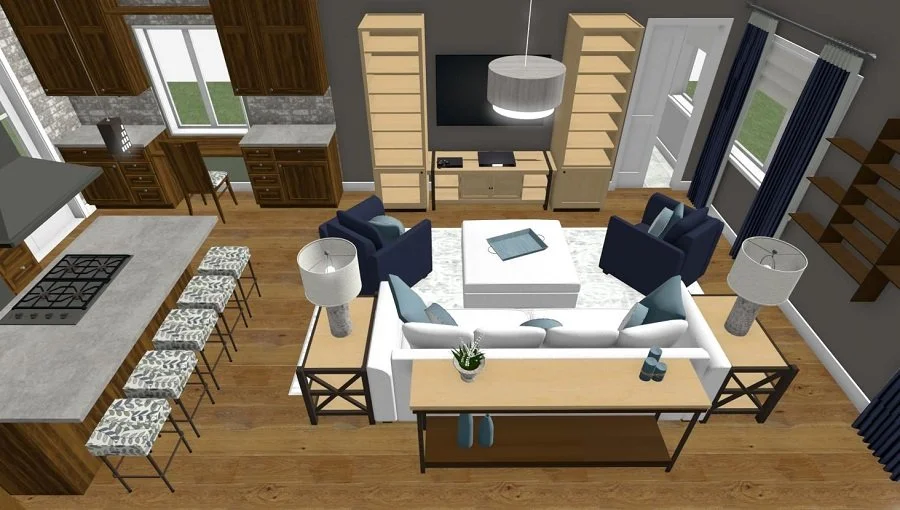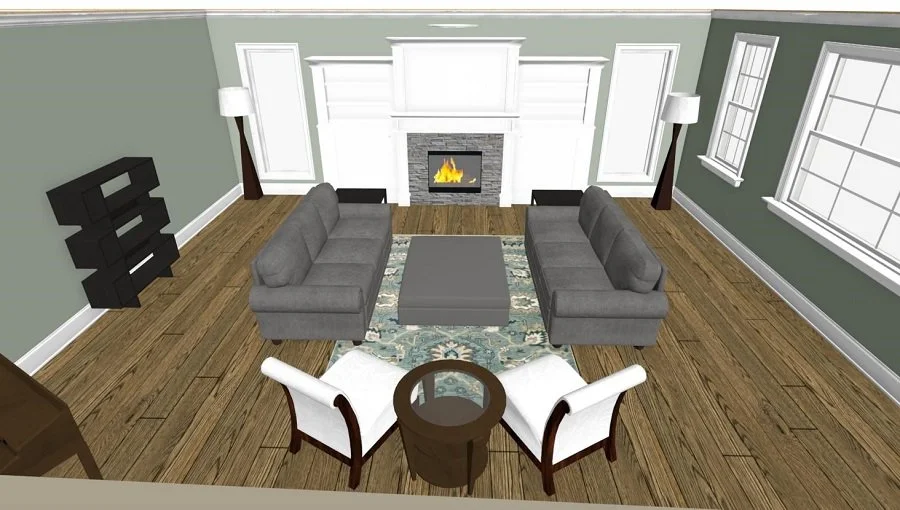Best Practices for Furniture Arrangement
Are you a “set it and forget it” person when it comes to furniture arrangement? If the answer is yes and you don’t THINK you have options, politely, you’re wrong. If you’re inexperienced or lack confidence, this blog is just what you need. Rearranging furniture is one of the easiest and most affordable ways to make a room feel new. It’s a core concept of redesign and one of my great pleasures in life. I’ve got six quick tips to help give your home a fresh look for the total cost of zero dollars. You don’t find bargains like that often, so stick around and let’s get our arrangement mojo in high gear!
These tips make most sense in a living room or family room, but you will find they also apply to different areas of your home.
Furniture Arrangement Tips
In this open-living plan, the furniture in the living area balances the cabinetry, island, and appliances in the kitchen area. This room is set up for conversation as well as for TV viewing. There is ample walking space to navigate the space easily.
1. Determine the activities you want to do in the room. This tip falls under the design axiom “form follows function,” meaning design your space AFTER you determine your needs. Otherwise you may end up with a room that looks great but isn’t functional. Here are some examples for how you might use a room: as a conversation area, a comfortable place to read with good lighting, a large open area to stretch, or a cozy spot to relax and enjoy the fireplace. While this tip may seem obvious, it often gets overlooked. Don’t be an over-looker.
2. Figure out the focal point. Every well-arranged room has a focal point, whether it’s built-in or something you create. It might be the TV, a fireplace, a beautiful piece of art or a special display that you create. Ideally your furniture arrangement will support and often encircle this focal point.
In this rendering, the focal point is the fireplace. The main furniture is set up for conversation. The two sofas balance each other out and the two chairs plus side table balance out the built-in and fireplace.
3. Balance your furniture within the space. Maybe you have a large four-person sofa and a couple of nice side chairs. Placing them across from each other helps create balance within the space. If you have some furniture that is “heavy” visually and other pieces with a lighter look, you will want to distribute them evenly throughout the room, mixing and matching the heavier pieces with the lighter to avoid having the room feel lopsided with all the heavy pieces on one side and the lighter on the other.
4. Understand traffic patterns. Consider how people navigate through the room as it is now and make sure there will be ample room with your new arrangement. Avoid creating a “roadblock” with a large piece of furniture that forces occupants to take a clumsy path around it. Ensuring you have a 30” to 36” pathway is a basic rule for allowing for convenient through-traffic.
In this rendering, the focal point is the television. We have addressed both a reading area and a work area. You’ll notice some of the furniture is against the wall and some of it is actually out in the central space of the room. There is also ample room for navigating around the room.
5. Leave ample space within your grouping(s). Let’s say you have a sofa with a coffee table in front of it. Similar to #4, ensure you have enough room to move in, out and around without having to turn in, out and around to get by. Leaving an 18” to 24” space is the guideline in this instance.
6. Use the whole room (including the middle). Don’t get caught placing all your furniture around the room against all the walls. C’mon, live a little! Don’t be afraid to place some furniture in the middle of the room. An example of this might be taking a large sofa and placing it against one wall of the room and taking a second sofa (or loveseat) and placing it adjacent to this sofa, which would bring it out into the center space of the room.
Final Thoughts on Rearranging Your Furniture
I hope these tips help you the next time you’re tired of the way a room looks but you don’t want to take a lot of time or spend any money to create a change. Also, remember the option of trading out some furniture pieces or accessories from other rooms in your home. Another great redesign tip where your only investment needed is a little time.
Now, what will you do next to love where you live?
Please feel free to reach out to us at The Redesign Habit and ask questions or simply share a project that you are working on or have completed.
For more great stories and ideas please follow us on Facebook and Instagram.



